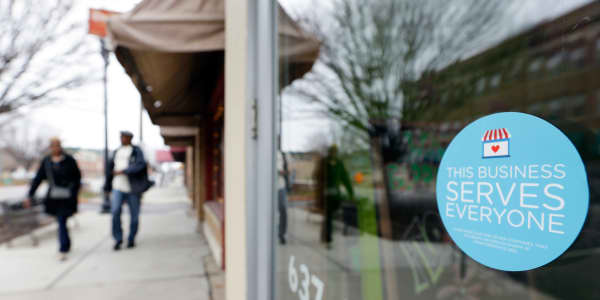Economies back from the brink
CNBC has been ranking the states since 2007, chronicling their competitiveness from the peak of the housing boom through the Great Recession and now into the recovery.
Here are the top state comebacks, comparing our America's Top States for Business rankings in 2009—at the depths of the recession—to today.
—By Scott Cohn, senior correspondent & Betsy Cline, producer, CNBC
Posted 24 June 2014
Nebraska
- 2014 rank: 4
- 2009 rank: 11
- Improvement: 7 places
As a Midwestern state with a characteristically stable economy, Nebraska did not suffer as badly as some states during the Great Recession. But the global crisis hurt demand for the state's agricultural products. Gov. Dave Heineman was midway through his first full term when the crisis hit. He has made tax reform a priority, with mixed success. Nebraska's regulatory climate had already made strides in our rankings, rising to sixth place from 28th in 2008. It has continued to improve and now ranks third.
Florida
- 2014 rank: 20
- 2009 rank: 28
- Improvement: 8 places
Florida was among the states hardest hit by the foreclosure crisis, and the effects were evident in 2009. We ranked Florida's economy 43rd in the nation that year. This year, it has rebounded to 11th, as the housing cycle has turned—prices are appreciating, while supply has stabilized. But the recovery is uneven. Nearly a third of Florida mortgages are still underwater, according to RealtyTrac, the highest percentage in the nation.
Mississippi
- 2014 rank: 36
- 2009 rank: 45
- Improvement: 9 places
When the crisis hit in late 2008, Mississippi was still reeling from another disaster just three years earlier—Hurricane Katrina. Then-Gov. Haley Barbour and the legislature responded by drastically cutting spending, including nearly $42 million in cuts in fiscal 2009 alone. Today revenues have rebounded. The state has also taken steps to reform a legal system perceived to be plaintiff-friendly, but many believe considerable work remains.
Wisconsin
- 2014 Rank: 17
- 2009 Rank: 26
- Improvement: 9 places
Wisconsin's housing market didn't boom the way some parts of the country did, so that helped temper the bust during the financial crisis. Still, job losses were severe. Gov. Scott Walker took office in 2011 with a promise of reforming the business climate and creating 250,000 private-sector jobs in his first term. Wisconsin has added only about 40 percent of that number, though job growth is accelerating. Wisconsin's rankings on costs, workforce and business friendliness have barely moved despite Walker's reforms, but the state economy's ranking has jumped.
Washington
- 2014 Rank: 7
- 2009 Rank: 16
- Improvement: 9 places
Washington State's heavy reliance on construction and on international markets for its products left the state especially vulnerable to a global economic crisis. Then-Gov. Christine Gregoire and the legislature slashed spending and reformed the budget process. While the state still faces serious fiscal issues, the economy has rebounded well, due in large part to Washington's tech sector. The state is also projecting a $51 million revenue increase this year, thanks to the production and sales of marijuana, which the state legalized in 2012.
Georgia
- 2014 Rank: 1
- 2009 Rank: 10
- Improvement: 9 places
Real estate is the largest sector of Georgia's economy, so the housing crisis truly hit the state where it lives. While Georgia maintained its top 10 status in our rankings throughout the crisis, thanks to its superior infrastructure and strong workforce, the recession hit hard. Unemployment topped out at 10.4 percent in 2009, remaining in double digits through 2010. Today the housing market has worked through its excesses, while Gov. Nathan Deal and the state legislature have slashed spending. Unemployment remains high and the state's education system is troubled, but jobs are returning and the recovery is gaining steam.
Ohio
- 2014 Rank: 18
- 2009 Rank: 29
- Improvement: 11 places
From Ohio's prerecession peak at the end of 2006 to the lows at the end of 2009, Ohio lost more than 400,000 jobs—mostly high-paying manufacturing jobs. Many of those positions are still lost and unlikely to return. So the state has targeted new industries, including biotech, medical equipment and energy production. While experts say the state is still years away from a full recovery, job growth in those industries is picking up and powering a comeback.
South Carolina
- 2014 Rank: 24
- 2009 Rank: 37
- Improvement: 13 places
As in many coastal states, the housing boom and bust had an exaggerated effect in South Carolina. The state's heavy reliance on manufacturing—the second-largest sector of the state economy after housing—deepened the downturn as well. Since then, the housing market has stabilized, and manufacturing has come back in a big way. In 2009, Boeing took full control of a joint venture manufacturing facility in North Charleston, which produces sections of the 787 Dreamliner and is expanding. BMW recently announced a $1 billion upgrade at its plant in Spartanburg. South Carolina's unemployment rate is back below the national average.
Michigan
- 2014 Rank: 26
- 2009 Rank: 41
- Improvement: 15 places
No state took a more direct hit from the financial crisis than Michigan. The panic pushed the Big Three automakers to the brink of bankruptcy; GM and Chrysler soon went over the edge. Unemployment hit a staggering 14.2 percent in August 2009. The U.S. government rescued the automakers, temporarily taking an ownership stake as they reorganized and returned to profitability. Gov. Rick Snyder and the state legislature cut taxes and replenished the state's rainy day fund, and the troubled city of Detroit is in the midst of a historic reorganization. Employers have begun absorbing the state's flood of available workers, and the jobless rate is roughly half what it was at the recession's peak.
Nevada
- 2014 Rank: 29
- 2009 Rank: 47
- Improvement: 18 places
The Great Recession was a body blow to Nevada. The state had been enjoying dizzying growth as the housing market took off and tourism and mining boomed. Then the crisis hit, and everything came up craps. Unemployment peaked at 13.9 percent and didn't fall below 10 percent until last year. Today the tourists are coming back and so are the jobs, with employment growth outpacing the rest of the country. Housing prices have begun to rise again, too, as the market begins to rebalance. But Nevada has much ground to make up, and many experts say a full recovery could still be several years away.





